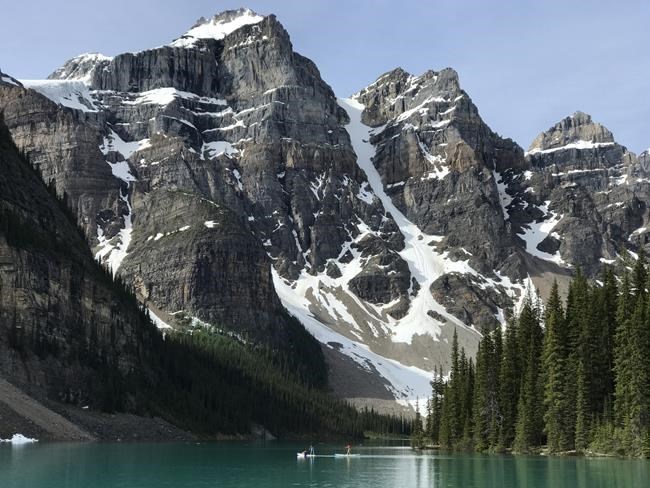LAKE LOUISE, Alta. — A decision to restrict personal vehicles at one of the most popular tourist destinations in Banff National Park was required to balance the growing number of visitors with protecting the environment, says a Parks Canada official.
The federal agency announced Friday that it was closing the Moraine Lake road to most personal vehicles and would require visitors to take its shuttles, local transit, or commercial vehicles to visit the iconic blue alpine lake and its nearby climbing routes and hiking trails.
Environmental groups said it's a good start to protect the ecological integrity of the national park, while some — including some Alberta politicians — said it could reduce visitor access to the popular tourist area.
Premier Danielle Smith said she's disappointed the province wasn't told about the decision.
"They didn't even call our parks minister," she told reporters in Calgary on Tuesday. "We want to make sure there's more accessibility."
Smith acknowledged, however, that national parks are federal jurisdiction.
Jed Cochrane, Parks Canada's visitor experience manager for the Lake Louise, Yoho and Kootenay field unit, said the move was necessary to improve people's trips to the area.
"Moraine Lake is one of the most sought-after, if not the most sought-after, destination to visit in Banff National Park. It's really busy." Cochrane said in an interview Monday.
"We just want to be clear with visitors that it is very hard — and it was very, very hard last summer — to access Moraine Lake by private vehicle and we heard from visitors that they were very frustrated."
Cochrane said the parking lot at the end of the narrow 12-kilometre road only has room for about 100 vehicles at a time.
"We would allow about 900 cars a day up to Moraine Lake and we carefully managed that to make sure the parking lot wasn't over capacity and that emergency vehicles could get in," he said. "We turned away 5,000 cars a day."
Some visitors, he said, will now be guaranteed access if they book the Parks Canada shuttle or use a commercial operator. People with a disability hang-tag on their vehicle and those who want to bike, including electric bikes, are still allowed to drive up the road.
The move at Moraine Lake isn't unprecedented as parks across North America try to find ways to balance the number of visitors in popular areas with safety and environmental concerns.
Lake O'Hara, a pristine alpine area across the British Columbia boundary in Yoho National Park, has long restricted private vehicles on its access road and has a reservation system for day use and camping that can only be booked by winning a lottery.
BC Parks also brought in a day-use pass program in June 2022 to visit three popular provincial parks — Golden Ears, Joffre Lake and three trailheads at Garibaldi — during peak hours.
Some parks in the United States, such as Zion National Park, only allow access by shuttle bus or by special permit for people with certain medical needs.
Cochrane said Parks Canada has talked to officials at Zion and BC Parks about those moves. The agency also had an expert panel look at the best way to get the more than four million visitors who visit Banff National Park annually around in a sustainable way and it recommended the move.
"They have a suite of other considerations for us to think about," he said, explaining other measures are still being considered to reduce traffic congestion.
"At the end of the day, we really just want to improve visitor experience and balance our mandate between ecological integrity and visitor experience."
Cochrane said the road to Moraine Lake runs across a major wildlife corridor for grizzly bears and elk.
"When we remove 900 cars a day, we are improving wildlife's ability to move back and forth across," he said. "By encouraging visitors to use mass transit and to come in a more efficient way, we think that will improve wildlife movement."
Katie Morrison, executive director of southern Alberta chapter of the Canadian Parks and Wilderness Society, said it's a good decision.
"In all the Rocky Mountain national parks, but especially Banff, we've seen huge increases in visitor use over the past several years," she said. "We know this can have an effect both on people's experience in the park but also things like wildlife and wildlife movement."
Morrison said the organization has long asked Parks Canada to address the massive increase in visitors.
"Someone doesn't want to go to Banff and drive around in circles all day," she said. "So, giving some certainty of … how people are going to arrive at places like Moraine Lake is a really positive thing."
This report by The Canadian Press was first published Jan. 10, 2023.
— By Colette Derworiz in Calgary.
The Canadian Press




